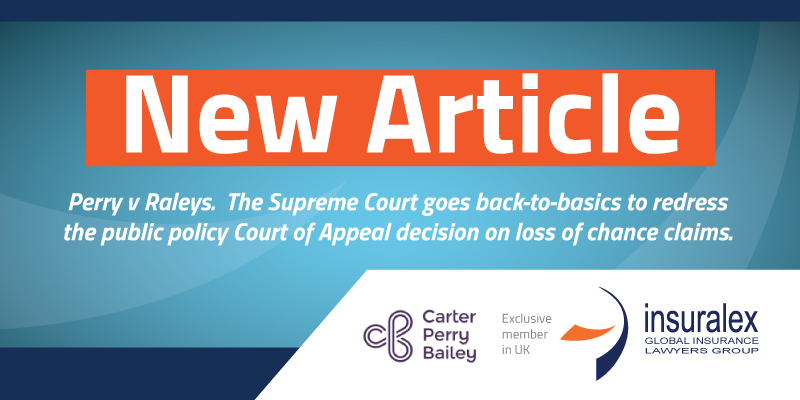
‘Loss of chance’ claims continue to attract interest from the Courts. In our latest article Mark Aizlewood considers the Supreme Court decision in Perry v Raleys.
The Supreme Court goes back to basics to redress the public policy Court of
Appeal decision on loss of chance claims
Introduction
The Supreme Court has, in its first opportunity to consider such principles, reiterated the approach the courts must take when considering causation in loss of chance cases. The decision makes it clear what has to be proved in cases where the question for the court depends on what a claimant would have done (which the claimant must prove ‘on the balance of probabilities’) against what third parties would have done (assessed on a loss of chance basis).
Background
In 1996 Mr Perry (a retired miner) instructed Raleys Solicitors to pursue a personal injury claim for Vibration White Finger (“VWF”). The VWF compensation scheme allowed both general and special damages. A claimant was entitled to claim (as special damages) compensation in respect of routine tasks that he could not carry out without assistance because of his injury (a Services Award).
Mr Perry’s claim for general damages was successfully settled, but no claim was made for Services.
Some years later Mr Perry brought proceedings against Raleys, claiming that he had lost the opportunity to claim a Services Award due to their negligent advice. At trial, Raleys admitted breach but resisted the claim on causation and loss.
First instance decision
At first instance, HHJ Saffman upheld Raleys’ argument on causation and concluded that Mr Perry had not established that he “honestly” met the “factual matrix” for making a claim for Services. The Judge did not accept that Mr Perry could not perform the tasks unaided. Mr Perry appealed to the Court of Appeal.
Court of Appeal
Lady Justice Gloster delivering the unanimous ruling of the Court of Appeal upheld the appeal holding that in effect the Judge had carried out a determination on the balance of probabilities as to whether Mr Perry
would have succeeded in his Services claim.
In what was an undoubtedly outspoken and pro-claimant judgment, Gloster LJ stated that there were “sound public policy reasons” behind her decision: “It is far too easy for negligent solicitors, or, perhaps more pertinently, their insurers, to raise huge obstacles to claimants such as Mr Perry from pursuing their claims, if the latter are required, effectively, to prove in the litigation against solicitors that they would have succeeded in making such a claim against the third party.
Raleys’ defence in the present case is an unfortunate exemplar of insurers putting the claimant to proof of every issue in the underlying claim. Such an approach is intellectually unsound; it requires the court, inevitably many years later, to investigate whether a claimant, who as here, may be unsophisticated and not have kept records, to prove what he would have done many years earlier.
In cases of admitted or proven negligence, on the part of solicitors or other professionals, that should not be the correct approach. Nor, in my view, do the authorities support it.”
The decision of The Supreme Court
Much to the relief of professionals and their professional indemnity insurers, the Supreme Court reversed the Court of Appeal’s decision, reinstated the judgment at first instance, and reaffirmed that causation is
for a claimant to prove.
The Supreme Court stated that the correct approach is that set out in Allied Maples Group Ltd v Simmons and Simmons, which identified a “clear and common-sense dividing line” between:
- those matters which a claimant must prove on the balance of probabilities: where the question of whether the claimant would have been better off depends on what he / she would have done had they been properly advised; and
- those which should be assessed on the basis of a lost chance: where the alleged beneficial outcome depends on what others would have done (involving hypothetical counter-factual and/or future scenarios).
Whilst the Supreme Court was clear that where the question for the court turns upon the assessment of a lost chance, it is inappropriate to conduct a “trial within a trial” that does not extend to a claimant’s own conduct; that must be proved on the balance of probabilities.
Applying these principles to the facts, the Supreme Court held that as the question to be determined (i.e. could he have brought an honest claim for a Services Award) turned on his conduct, Mr Perry’s claim was a “balance of probabilities” type case. As such Raleys were entitled to challenge the claim without limitation.
CPB Comment
The decision is beneficial to those representing professionals in such cases and redresses “the Court of Appeal pro claimant decision”. It makes it clear that the restrictions on a ‘trial within a trial’ does not prevent professionals and their insurers challenging a claimant’s case on what they would have done if correctly advised in order to resist causation.
The Supreme Court has sent out a clear message to the courts below that the Court of Appeal’s public policy based decision was entirely wrong, and has reaffirmed that it is for a claimant to establish causation on the balance of probabilities.
It should act as a reminder to the lower courts that they should not allow the loss of a chance principle to be adopted where matters which turn on what the claimant (as opposed to third parties) would have done if properly advised. It has reset the clock back to Allied Maples and this is to be welcomed.

Mark Aizlewood
Partner
T: 0203 697 1908
M: 07469 852355
“This information has been prepared by Carter Perry Bailey LLP as a general guide only and does not constitute advice on any specific matter. We recommend that you seek professional advice before taking action. No liability can be accepted by us for any action taken or not as a result of this information, Carter Perry Bailey LLP is a limited liability partnership registered in England and Wales, registered number OC344698 and is authorised and regulated by the Solicitors Regulation Authority. A list of members is available for inspection at the registered office 10 Lloyd’s Avenue, London, EC3N 3AJ.”





